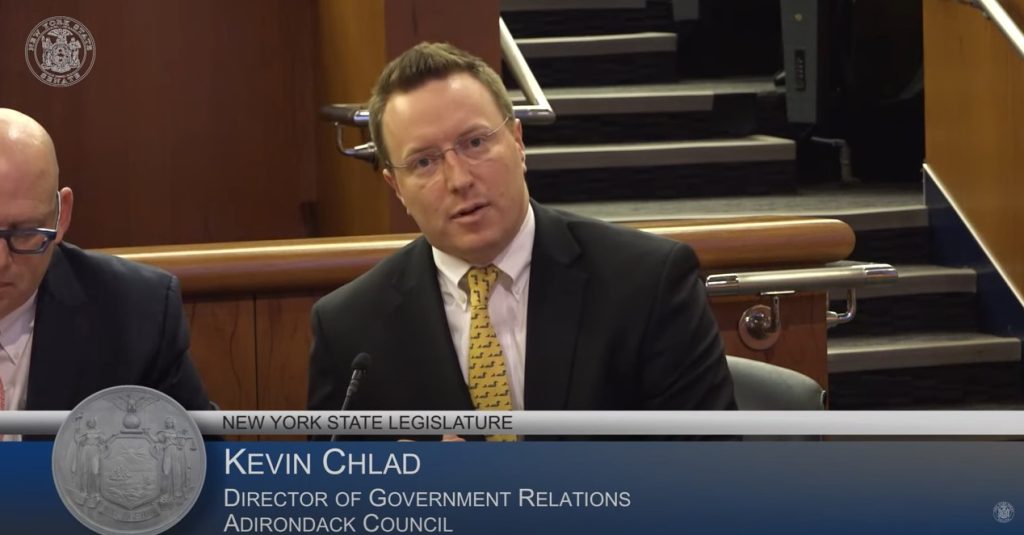Council Challenges State to Fund Safer, Affordable, More Climate-Friendly New York
Wednesday, February 7, 2024
ALBANY, NY – The Adirondack Council today called on the NYS Legislature to restore funding to key Adirondack environmental and diversity programs that were trimmed or eliminated in Gov. Kathy Hochul’s recent executive budget proposal, including the Clean Water Infrastructure Act, Adirondack Diversity Initiative, Timbuctoo Summer Climate and Careers Institute and Survey of Climate and Adirondack Lakes Ecosystems (SCALE).
In written testimony to a joint hearing of the Senate and Assembly on the Environmental Conservation portion of the FY 24-25 Executive Budget, Adirondack Council Director of Government Relations Kevin Chlad said the organization was working with partners to establish strong, enduring connections between the rural Adirondack Park and urban communities across the state. Critical programs cut from the Governor’s budget proposal can ensure that the Adirondack Park remains relevant to all New Yorkers — fighting climate change, protecting clean air and water, and helping the Park become more welcoming and appealing for all New York residents.
“Highly populated regions of our state face the specter of severe flooding and storm impacts if we do not successfully address climate chaos,” he testified. “Large forested regions, the biggest of which are found in the Adirondacks, will retain water and absorb greenhouse gases. This will slow climate change and associated impacts if we take the necessary steps to protect (them).”
State government can also make it easier for people who live in big cities to visit and enjoy the Adirondacks and to find meaningful, rewarding employment helping to safeguard its forests and waters, he said. And the Park is home to scientific research on climate and air pollution that benefits all state residents, regardless of where they live, he said.
“Some progress has been made, but we urge the legislature to continue efforts to reclaim the Adirondack Park and ensure that it benefits all New Yorkers,” Chlad said.
Chlad asked the Legislature to provide:
- $3 million to the Survey of Climate and Adirondack Lake Ecosystems
- $2.1 million for the Timbuctoo Summer Climate Careers Institute
- $600 million for the Clean Water Infrastructure Act (Governor proposed $250 million)
- $10 million for Forest Preserve stewardship in the Adirondacks and Catskills
- $1 million for a recreational carrying capacity study for Adirondack lakes
- $420,000 for the Adirondack Diversity Initiative (Governor proposed $300,000)
The Council also asked for changes to the Governor’s proposal for a $400-million Environmental Protection Fund (EPF) for capital projects, including:
- Restore the $25 million that was diverted toward operating expenses in the Governor’s plan. The EPF is for capital projects only.
- Increase the open space protection category to $50 million, with $3 million for the Land Trust Alliance (LTA) Conservation Partnership Program and $1.5 million for the LTA Conservation Easement Program
- $20 million for invasive species prevention and eradication
- $900,000 for the Lake George Park Commission
- $1 million for Visitors Centers, including the SUNY School of Environmental Science and Forestry, Paul Smith’s College, and the High Peaks Information Center
- $600,000, to be divided equally for the Adirondack Watershed Institute at Paul Smith’s College to conduct Harmful Algal Bloom Research, for the Atmospheric Sciences Research Center at Whiteface Mountain Field Station for Trace Gas Monitoring and Cloud Collection, and for the Cary Institute of Ecosystem Studies.
Chlad concluded by calling for better funding to replace failing septic systems, especially those on lake shores and riverbanks.
“Greater investment and eligibility is needed for NYS State Septic System Replacement Fund to assist residents who have septic systems on Adirondack Lakes. The vast majority of wastewater controls surrounding these water bodies are decentralized and managed through homeowners’ septic systems,” he noted. “Many of these systems are outdated and failing, costing tens of thousands of dollars to replace. Setting aside additional funds through the Clean Water Infrastructure Act for the Septic System Replacement Fund, which can provide up to 50% of remediation costs, will go a long way to help Adirondack Lakes remain healthy.”
Chlad concluded by offering his thanks to the Environmental Conservation Committee Chairs in each house: Sen. Pete Harkham, D-Peekskill, and Assemblymember Deborah Glick, D-Manhattan.
Last week, Chlad offered in-person testimony to the joint Legislative hearing on the NYS Transportation budget, seeking speedy action on the recommendation of the Adirondack Road Salt Task Force.
The Adirondack Council doesn’t solicit or accept government grants. It is a privately funded, not-for-profit organization dedicated to ensuring the ecological integrity and wild character of the 9,300-square-mile Adirondack Park – the world’s largest intact temperate deciduous forest ecosystem and home to about 130,000 New York residents in 130 rural communities.
Established in 1975, the Adirondack Council is the largest environmental organization whose sole focus is the Adirondacks. The Council carries out its mission through research, education, advocacy, and legal action. The Adirondack Council envisions a Park with clean water and clean air, core wilderness areas, farms and working forests, and vibrant, diverse, welcoming, safe communities.
For more information: John Sheehan, Adirondack Council, 518-441-1340

